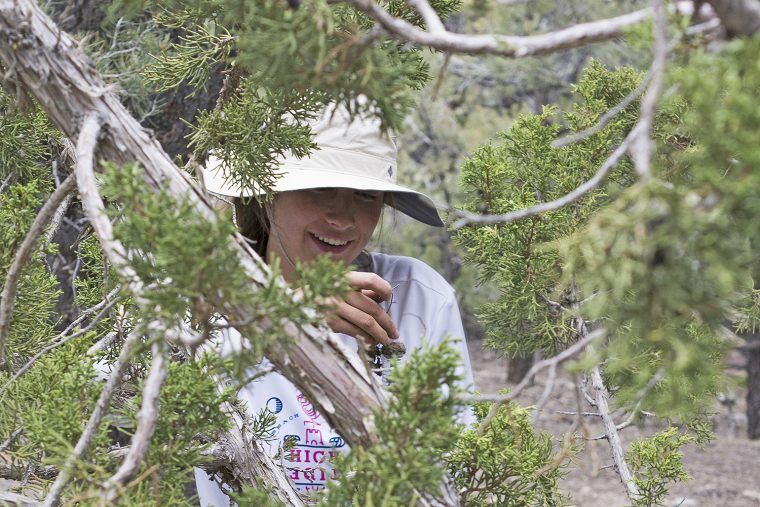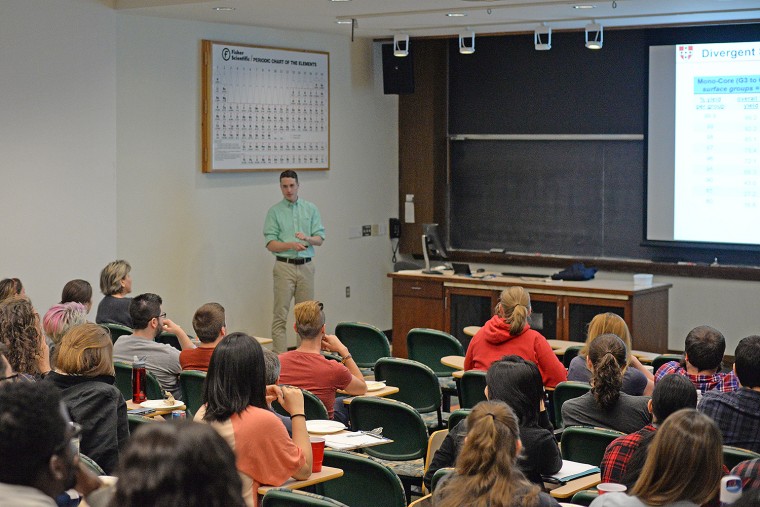This spring, a research team from Wesleyan traveled to Death Valley National Park to explore the ways bacteria diversifies in extreme environments. Death Valley, located about 130 miles west of Las Vegas, is a below-sea-level basin known for being the hottest place on earth and driest place in North America. The average rainfall is less than 2 inches, annually. "National parks are ideal for research, in general, because the land is protected indefinitely from commercial development," said team leader Fred Cohan, professor of biology, professor of environmental studies. "Death Valley is a nice model system for exobiology because of its extreme…
(more…)
Maya Gomes ’06 and her co-author Matthew Hurtgen published their paper, “Sulfur isotope systematics in a permanently euxinic, low-sulfate lake: Evaluating the importance of the reservoir effect in modern and ancient oceans,” in the June issue of the journal, Geology. In the paper, the authors present data that shows how geologists can use sulfur isotope compositions of marine sediments to discover variations in oceanic sulfate levels through Earth history. Gomes explained that the paper is very important to researchers who study the climate of the past because “marine sulfate levels play a role in regulating oxygen and carbon dioxide levels…
For the roughly one-third of temporal lobe epilepsy patients for whom drugs are not an option, researchers at Wesleyan are paving the way for alternative therapies using stem cells. Faculty members Janice Naegele, Gloster Aaron and Laura Grabel, together with Xu Maisano, Ph.D. ’11, Elizabeth Litvina, B.A. ’10/M.A. ’11, and Stephanie Tagliatela, the lab manager in the Naegele lab, recently published a landmark study in the Journal of Neuroscience on the use of embryonic stem cells to treat temporal lobe epilepsy (TLE). The researchers derived neural “parent cells” in culture from mouse embryonic stem cells, and transplanted them into the…
To determine the difference between a decisive and an indecisive person, follow the movements of their eyes. Andrea Patalano, associate professor of psychology, and Barbara Juhasz, assistant professor of psychology, have collaborated on research examining how decisive and indecisive people differ in their processing of information, which is a little-studied area. Their full findings are scheduled to be published in the near future, and both researchers are excited about what they found. Patalano has spent many years studying decision-making while Juhasz has spent time tracking readers’ eye movements using a device called an eye-tracker. Since the researchers were examining the…
Several Wesleyan faculty, graduate students and alumni participated in the 2009 Geological Society of America Annual Meeting Oct. 18-21 in Portland, Ore. Suzanne O'Connell, associate professor of earth and environmental sciences, director of the Service Learning Center, presented a research poster and delivered a presentation titled "Techniques and Tools for Effective Recruitment, Retention and promotion of Women and Minorities in the Geosciences." She spoke about the grant-funded organization Geoscience Academics in the Northeast (GAIN), which was established to build a community of academic geoscience women within a small geographic area. Johan Varekamp, the Harold T. Stearns Professor of Earth Science,…
5 Questions is a new feature in The Wesleyan Connection that will ask faculty members - surprise! - five questions about their work and activities. This issue, the questions go to Edward Moran, chair and associate professor of astronomy and director of the Van Vleck Observatory. His primary area of study is black holes. This summer he received a major National Science Foundation (NSF) grant for an extensive study on “intermediate mass” black holes. Q: Everyone thinks they know, but once and for all: what is a black hole? EM: Technically, black holes are places where matter has been crushed down…
Biology Ph.D candidate Kate Miller treks through a wildflower-lined trail alongside Middletown's Coginchaug River. She approaches a plastic garbage bin and a PCV pipe protruding from the ground. "That's my bat echolocation recorder," she says. “It’s old but I’m not complaining. It was free and it works.” Miller credits Scott Reynolds, Ph.D, of North East Ecological Services in Concord, N.H. for the loan of the equipment. Inside the crude setup is a 12-volt battery, an echolocation call recorder and lap-top computer. Every 1.5 seconds, the equipment translates the information into a graph and stores it as a data file on the…
In order for animals to detect food sources, avoid predators and find mates, they rely on their olfactory system, or sense of smell. The ability to detect and distinguish among thousands of environmental odorants is based on a combinatorial recognition system. A specific smell is coded in the brain by a specific combination of receptor proteins that get stimulated by the unique combination of odorant chemicals elicited by that scent. "The smell of 'lemons,' for example, would result from a specific combination of odorant receptor proteins that become stimulated upon binding the specific set of inhaled chemicals emitted from a…
(more…)
Anna Shusterman, assistant professor of psychology, recently received a five-year, $716,227 grant from the National Science Foundation (NSF) to study "The role of language in children’s acquisition of number concepts." Shusterman will be evaluating 3-to-5-year-old hearing children in her Cognitive Development Laboratory at Wesleyan. She also will be studying deaf and hard-of-hearing children of the same ages who are learning English to try to determine how language delays affect children's learning of number concepts. The grant, which begins this year, comes from the National Science Foundation's Faculty Early Career Development (CAREER) program. The program is only available to non-tenured faculty. Researchers…
Next fall, Wesleyan students and faculty will perform research activities on the same state-of-the-art animation computers that produced Ice Age the Meltdown, a $652 million worldwide box office hit. The computer hardware was donated July 2 by Greenwich, Conn.-based Blue Sky Studios, the creator of a number of award-winning digital animation features, including the Ice Age series and Dr. Seuss’ Horton Hears a Who, which took in nearly $300 million worldwide. In 2008, Blue Sky Studios refreshed their technology for their latest movie, Ice Age: Dawn of the Dinosaurs, and bought racks of new computers. "The old computer racks still…



